Leah is up to her ears in baby trees this week, transplanting and preparing them for a regional forest conservation tree give-away that’s coming up soon. Below are some photos and tidbits of tree lore written by Leah. Enjoy!
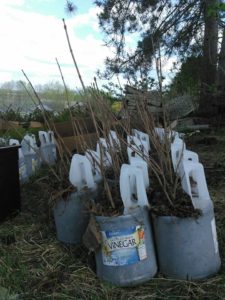
Highbush Cranberries
“Getting tree seedlings ready for the conservation giveaway next weekend. All are species suited to our area with habitat and restoration value. It may look motley, but it’s slowly taking shape, each with its own soil mix, root length and structure, and destined homes. Only about 1500 left to divide and containerize.”
Highbush Cranberries:
“Highbush cranberries, part of Acadian heritage cuisine. Smells like feet when you cook them, but they make a really unique tasting jam and sauce and the birds love them. Grows in the sun, often along field edges, disturbed verges, and the railroad tracks. These are 3 in a jug.”
Bur Oaks:
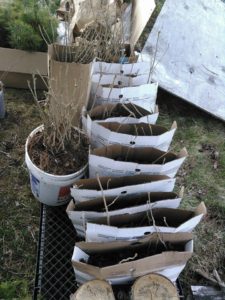
Bur Oaks
“Bur oaks, some grouped for planting on community land, some prepped in pizza boxes (it was the only thing that covered their roots!) for the public.
“Bur oaks have a deep taproot, up to 18 inches long even on these seedlings, and are an important wildlife feeder. With native beech populations declining under disease pressure, we’re promoting and planting oaks as a long lived hardwood replacement that bear nuts fruitfully. These grow massively, majestically large, spreading their crowns widely in the sun. Companion plant with pine for a beautiful mixed forest. These are 5 in a pizza box.”
Silver Maple & Furbish Lousewort:
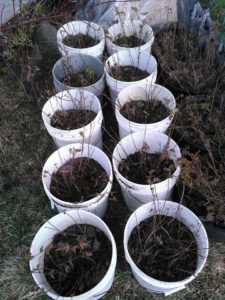
Silver Maples
“Silver maple will be planted in partnership with Inland Fish & Wildlife as part of the effort to preserve and promote the Furbish Lousewort.
“Furbish Lousewort is a small flowering plant that grows only along the St. John River. Discovered by Kate Furbish, a fascinating botanist in her mid-40s when she trekked her way to St Francis, the Furbish Lousewort grows where the ice jams scrapes the banks clear each spring.
“Because the headwaters of the St. John are further south than most of the Valley, it melts the runoff in the spring before the rest of the river has loosened up. That pressure pushes the ice jam each spring all the way to Grand Falls.
“We’ll be planting silver maple along the river banks to stabilize them, preventing erosion and tumbledowns, on both community and privately owned properties.
“Silver maples grow wicked fast, spread into tickets, are prone to breakage and blow over, which accelerates the creation of forest structures, and have a root system that fairly explodes laterally, making city planners regret planting them when they lift streets and sidewalks, rupture water lines, and dig into septic systems. Perfectly suited to our remote riverbanks, then.”
Northern White Cedar:
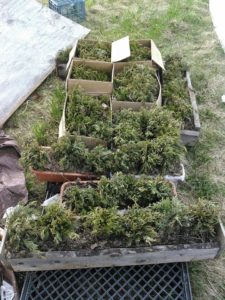
Northern White Cedar
“The Northern White Cedar, also known as the Arbre de Vie for its many medicinal and nutritional uses, is THE flagship tree species of the Acadian Forest. Only about 3,000 of the original 11,000 cedar left.
“That’s right, our original forest type is recognized as unique within the world, and under threat of homogenization from timber and resource extraction pressure.
“Cedar seepage is a specific forest type that is so rare that it has since been left out of forestry typing guides, but 6 out of 11 known areas in New England are in Northern Maine.
“Cedars are slow growing, can live up to 400 years, and provide important winter deeryard shelter. Because they are so slow growing, they’re not regenerating at the same rate as they’re being logged, and harvested areas get overrun with more opportunistic succession species.
“While I’m not a huge fan of deer myself, they serve as a barometer of ecosystem health in our area. The St. John Valley is at the upper end of their range, and their populations do not persist or thrive without the right conditions. When the deer are healthy, it’s one indication that the ecosystem is healthy. When the deer die off or need supplemental feeding, it’s an indication of an ecosystem under stress.
“And so, we plant. These will go to community plantings, and will be divided up to give to the public in batches of 25 (haven’t gotten to that yet…).
“They like their feet wet as long as the water flows. No stagnant water plantings, but wet areas with seepage do just fine.”
White Pines:
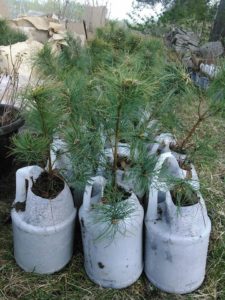
White Pines
“White pines were once ubiquitous in Aroostook several generations of forest ago, though you wouldn’t know it today. Less likely to be marked as ‘King Pines’ for British ship masts, these trees nonetheless built the grand old houses of Houlton, where the Northern lumber barons lived in the 1800s.
“We plant them today to increase the biodiversity we’ve lost, and to provide the eagles with places to perch. White pines grow rapidly and are part of the forest structures needed by many wildlife species, including the pine marten, which needs over 1,200 acres of contiguous home range for one mating pair. Many critters need tall trees, deadfalls, leaning snags, overlapping branches, and a thriving forest floor environment to do well. Diversity is a necessity.
“We’ll be reserving some of these for landowners with riverbanks who want to plant for eagle perches down the road. The rest will be available to the public 1 in a jug.
“They like full sun, but they don’t like to be alone. They are susceptible to weevil damage if planted only with their kind or by themselves. Plant them with oaks or other sun-loving species to give them a friend.”
Red Spruce:
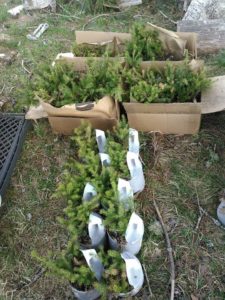
Red Spruce
“This is the first year red spruce has been available for our conservation efforts. Red spruce is native in our area, but serves as a great wildlife species, providing small critter (rodent, birds) shelter and food (tip browsing for deer, moose, and snowshoe hares, cones to birds and red squirrels).
“We’ll be planting some on community properties and giving the rest away to the public, 5 in a jug. They like sun, but MOST importantly, they do NOT do well in a monoculture or plantation. Mix them up with other species to keep them happy.”